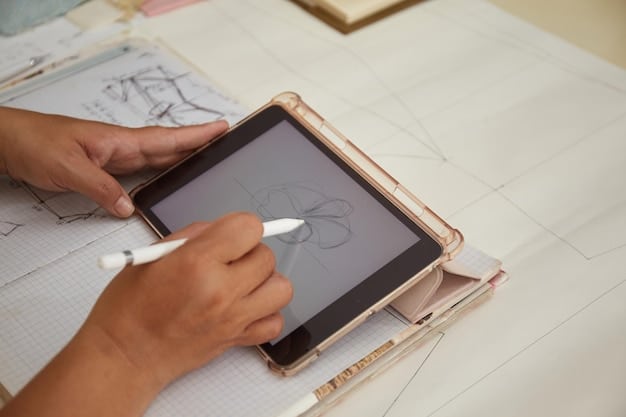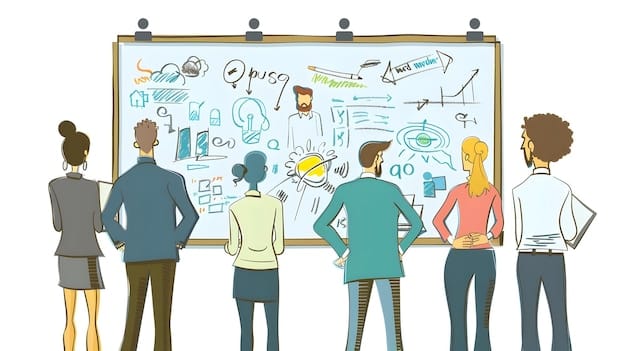Design Thinking for Problem Solvers: 5-Step Innovation Process

Applying Design Thinking for Problem Solvers: A 5-Step Process for Innovation in Any Industry offers a human-centered approach to tackling complex challenges, fostering creativity and delivering impactful solutions across diverse sectors by empathizing with users, defining problems clearly, ideating broadly, prototyping solutions, and rigorously testing them.
In a world of constant change, the ability to innovate and solve problems effectively isn’t just an asset; it’s a necessity. This is where Design Thinking for Problem Solvers: A 5-Step Process for Innovation in Any Industry emerges as a powerful framework. But what exactly is this methodology, and how can it transform the way we approach challenges?
Empathy: Understanding the User at the Core
The first and arguably most crucial step in the design thinking process is empathy. This isn’t just about feeling sorry for someone; it’s about deeply understanding the needs, desires, behaviors, and pain points of the people you are designing for. Without this foundational understanding, any solution created risks missing the mark entirely.
To cultivate true empathy, designers and problem solvers must move beyond assumptions and engage directly with their target audience. This involves a range of qualitative research methods aimed at uncovering unspoken needs and gaining genuine insights into their experiences. The goal is to see the world through their eyes, walking in their shoes, and understanding their unique challenges firsthand.
Techniques for Building Empathy
Building empathy is an active process that requires dedicated effort and specific techniques. It’s about immersing yourself in the user’s world and gathering rich, qualitative data that numerical statistics alone cannot provide.
- User Interviews: Conduct one-on-one conversations to explore users’ perspectives, experiences, and emotions related to the problem space. Ask open-ended questions to encourage detailed responses.
- Observation: Watch users interact with products, services, or environments in their natural settings. Pay attention to their actions, body language, and moments of struggle or delight.
- Contextual Inquiry: Combine observation with intermittent questioning as users perform tasks, allowing for real-time insights into their workflow and decision-making processes.
- Journey Mapping: Visualize the entire user experience, from their first interaction to their last, identifying touchpoints, emotions, and specific pain points along the way.
The insights gained from these empathy-building exercises form the bedrock of the entire innovation process. They ensure that subsequent steps are grounded in real-world needs, leading to solutions that are not only functional but also truly resonate with the users.
Ultimately, empathy isn’t a one-time activity but an ongoing mindset. It means continually checking back with users, revisiting their perspectives, and allowing their evolving needs to guide the development of solutions. This deep connection ensures that innovation serves a genuine purpose and delivers meaningful value.
Define: Crafting the Problem Statement
Once you’ve empathized with your users, the next critical step is to define the problem. This phase involves synthesizing all the insights gathered during the empathy stage and framing them into a clear, actionable problem statement. It’s about articulating the core challenge you’re trying to solve, pinpointing the specific needs of the user, and identifying the key insights that will anchor your innovation efforts.
A well-defined problem statement is crucial because it provides focus and clarity. Without it, problem-solving can become scattered and inefficient, leading to solutions that don’t address the most pressing issues. The goal here is to shift from broad observations to a concise, user-centered “Point of View” (POV) statement.
A good POV statement typically follows a structure like: “[User] needs to [User’s Need] because [Insight].” For instance, “A busy professional needs to quickly find healthy meal options because they lack time for meal prep and often resort to unhealthy fast food.” This framework ensures the problem is framed from the user’s perspective, is specific, and grounded in the gathered insights.
Synthesizing Research and Framing the Challenge
Defining the problem isn’t just about writing a sentence; it’s a process of deep analysis and synthesis. It requires meticulously sifting through the vast amount of data collected during the empathy phase to identify patterns, recurring pain points, and surprising discoveries. Tools like affinity diagrams, where observations are grouped into themes, can be immensely helpful in this stage.
- Affinity Mapping: Organize observations and insights from interviews and observations into logical groups based on common themes or relationships.
- Persona Development: Create fictional representations of your key user segments based on the synthesized data, detailing their motivations, goals, and frustrations.
- Problem Framing Workshops: Facilitate sessions with your team to collectively analyze observations, challenge assumptions, and collaboratively articulate the problem statement from various angles.
This definition phase acts as a funnel, taking broad, raw information and refining it into a tightly focused problem to be solved. It provides a shared understanding for the entire team, ensuring everyone is aligned on the specific challenge. A clear problem statement not only guides the ideation process but also serves as a benchmark against which potential solutions can be evaluated. When the problem is clearly defined, the path to innovative solutions becomes much clearer and more purposeful.
Ideate: Brainstorming Creative Solutions
With a clearly defined problem statement in hand, the next phase is to ideate—to generate a wide range of potential solutions. This stage is all about quantity over quality, encouraging wild ideas and suspending judgment. The aim is to think outside the box, challenge assumptions, and explore as many diverse possibilities as possible, no matter how unconventional they may seem at first glance.
Ideation thrives on creativity and collaboration. It’s an opportunity for teams to diverge in their thinking before converging on the most promising concepts. By fostering an environment where every idea is welcome, even the seemingly absurd ones, teams can uncover truly innovative approaches that might otherwise be overlooked. This phase builds directly on the empathy and definition stages; solutions generated here are specifically aimed at addressing the clearly articulated user needs and problems.
It’s important to remember that during ideation, no idea is a bad idea. Criticism and feasibility concerns are set aside temporarily to allow for maximum creative flow. The goal is to expand the solution space as much as possible, pushing the boundaries of what is considered possible or conventional. This expansive thinking is what often leads to breakthrough innovations.
Techniques for Fostering Diverse Ideas
There are numerous techniques to spark creativity and generate a wide array of ideas. These methods are designed to break down mental blocks and encourage participation from everyone involved, ensuring a rich pool of concepts.
- Brainstorming: A classic method where participants freely generate ideas related to the problem statement. Rules include: defer judgment, encourage wild ideas, build on others’ ideas, and go for quantity.
- Brainwriting: A quieter alternative where individuals write down their ideas silently before sharing them, which can be particularly effective for introverted team members.
- SCAMPER Method: A checklist of prompts to inspire new ideas by thinking about how to Substitute, Combine, Adapt, Modify, Put to another use, Eliminate, or Reverse elements of an existing concept or problem.
- Mind Mapping: Visually organize ideas around a central problem, showing connections and stimulating further thoughts.
The ideation process should culminate in a large pool of diverse concepts. From this pool, the team will later select the most promising ideas to move forward with, often by voting or discussing their potential impact and alignment with the defined problem. The richness of this initial pool directly correlates with the potential for truly innovative and effective solutions in later stages.

Prototype: Bringing Ideas to Tangible Form
After generating a multitude of ideas, the next crucial step is to prototype. This phase involves transforming selected ideas into tangible, albeit low-fidelity, representations. A prototype can be anything from a simple sketch, a storyboard, a physical model, or even a basic digital wireframe. The aim is not to create a polished, final product, but rather a quick and inexpensive way to materialize concept ideas for observation and feedback.
Prototyping serves several vital functions. Firstly, it makes abstract ideas concrete, allowing stakeholders and potential users to interact with a physical manifestation of a solution. This interaction is invaluable because it surface issues that might not be apparent in a conceptual discussion. Secondly, it facilitates rapid iteration. By creating prototypes quickly and cheaply, teams can test multiple ideas without investing significant resources, allowing for quick adjustments based on feedback.
This hands-on approach allows for a deeper understanding of the strengths and weaknesses of an idea. It shifts the focus from theoretical discussions to practical interactions, making it easier to identify flaws and opportunities for improvement. The goal is to learn as much as possible, as quickly as possible, by putting ideas into a testable form.
Creating Rapid and Low-Fidelity Prototypes
The essence of successful prototyping lies in its speed and affordability. The emphasis is on learning by doing, not on perfection. These rapid prototypes are disposable; they are meant to be tested, validated, and often discarded or iterated upon almost immediately.
- Paper Prototypes: Simple sketches or drawings on paper can simulate user interfaces or product layouts. They are extremely fast to create and modify.
- Role-Playing or Storyboarding: For service-oriented solutions, enacting a scenario or drawing out a flow of events can simulate the user experience without building anything physical.
- Basic Wireframes/Mock-ups: Digital tools can be used to create simple, non-interactive layouts of digital products, focusing on structure and content rather than visual design.
- Cardboard Models: For physical products, using everyday materials like cardboard, clay, or LEGOs can quickly bring a concept to life in three dimensions.
The process of prototyping encourages a “fail fast, learn faster” mindset. Each prototype is an experiment designed to answer specific questions about the chosen solution. This iterative cycle of building and testing reduces risk by identifying potential problems early in the development process, saving significant time and resources in the long run. By making ideas tangible, prototyping brings clarity and momentum to the innovation journey.
Test: Gathering Feedback and Iterating
The final and equally crucial step in the design thinking process is to test your prototypes. This phase involves putting your tangible solutions in front of real users, gathering their feedback, and learning from their interactions. It’s a prime opportunity to validate assumptions, uncover unforeseen problems, and understand whether your solution truly meets the user’s needs as defined in the earlier stages.
Testing is not merely about confirming that something works; it’s about observing how users interact, listening to their comments, and paying close attention to their non-verbal cues. This feedback loop is essential for refining the solution and iterating on the design. The insights gained from testing often lead to a deeper understanding of the problem and potential ways to improve the solution.
This phase often reveals opportunities for further refinement, or even leads the team to cycle back to an earlier stage of the process, such as ideation or even empathy, if fundamental assumptions are invalidated. This iterative nature is a cornerstone of design thinking, reinforcing that innovation is rarely a linear path.
Observing, Listening, and Iterating Based on Feedback
Effective testing requires more than just showing a prototype and asking, “Do you like it?” It demands careful observation and active listening. Facilitators should create a comfortable environment where users feel free to offer honest, unvarnished feedback.
- Usability Testing: Observe users as they attempt to complete specific tasks with the prototype. Note where they struggle, get confused, or complete tasks with ease.
- A/B Testing (if applicable): Compare two versions of a design to see which performs better based on specific metrics.
- Feedback Sessions: After user interaction, conduct structured conversations to elicit detailed feedback, asking open-ended questions about their experience, pain points, and desires.
- Iterative Refinement: Based on the feedback, make necessary adjustments to the prototype. This often means going back to the drawing board for certain elements, re-prototyping, and testing again.
The test phase is continuous and iterative. It’s rare for a solution to be perfect after the first round of testing. Instead, the process involves repeated cycles of testing, learning, and refining, gradually moving closer to an optimal solution. This iterative improvement driven by real user feedback is what makes design thinking so powerful in producing truly user-centered and impactful innovations.

Beyond the 5 Steps: Iteration and Implementation
While the five core steps—Empathize, Define, Ideate, Prototype, and Test—provide a clear framework for problem-solving, it’s crucial to understand that design thinking is not a linear process. It’s highly iterative, meaning that teams frequently cycle back to earlier stages based on new insights or challenges encountered. For example, testing a prototype might reveal a deeper user need, sending the team back to the empathy or define phase. This fluidity is what makes the methodology so powerful and adaptable.
The true value of design thinking lies not just in following the steps, but in fostering a mindset of continuous learning and improvement. Each cycle of “Empathize, Define, Ideate, Prototype, Test” strengthens the solution, reducing risk and increasing the likelihood of success. It’s an ongoing dialogue between the design team and the users, ensuring that the created solution remains relevant and impactful as needs evolve.
Once a solution is refined through multiple iterations and proves effective in testing, the final stage moves towards implementation. Even then, the design thinking principles of observing and adapting should continue, as real-world deployment often uncovers new insights and opportunities for further enhancement. This continuous feedback loop ensures long-term relevance and effectiveness of the innovation.
Integrating Design Thinking into Organizational Culture
For design thinking to truly flourish, it needs to be more than just a project methodology; it needs to be embedded into the organizational culture. This involves encouraging cross-functional collaboration, fostering a user-centered mindset across all departments, and embracing experimentation. It’s about empowering employees at all levels to identify problems, propose solutions, and test them with real users, regardless of their formal role.
- Cross-functional Teams: Form diverse teams with members from different departments (e.g., engineering, marketing, sales, customer service) to bring varied perspectives to the problem.
- Leadership Buy-in: Secure strong support from leadership that champions the design thinking mindset and allocates resources for its implementation.
- Training and Workshops: Provide ongoing training to familiarize employees with design thinking principles and tools, building internal capabilities.
- Celebrating Small Wins: Recognize and celebrate successful applications of design thinking, even on a small scale, to build momentum and encourage wider adoption.
By fostering an environment that values curiosity, empathy, and iteration, organizations can transform their approach to problem-solving. Design thinking becomes a sustainable capability, enabling companies to continuously adapt, innovate, and deliver exceptional value in an ever-changing marketplace. It’s a pathway to not just solving today’s problems, but building the capacity for future innovation.
| Key Stage | Brief Description |
|---|---|
| ❤️ Empathize | Understand user needs and pain points through direct observation and interaction. |
| 📝 Define | Formulate a clear, human-centered problem statement based on insights gathered. |
| 💡 Ideate | Brainstorm radical solutions to the defined problem, promoting quantity and creativity. |
| 🧪 Prototype & Test | Build low-fidelity versions of solutions, test with users, and iterate based on feedback. |
Frequently Asked Questions about Design Thinking
Design thinking distinguishes itself through its human-centered approach, starting with deep empathy for the user. Unlike traditional methods that might jump straight to solutions or focus on technical feasibility first, design thinking prioritizes understanding user needs, iterative prototyping, and continuous feedback, fostering more innovative and user-friendly outcomes.
Absolutely. While originating in product design, the principles of design thinking are universally applicable. It’s used in healthcare to improve patient experiences, in education to enhance learning, in finance to streamline services, and within government to create better public policies. Its flexibility lies in focusing on understanding human needs, regardless of the sector.
The empathy phase is paramount. It forms the foundational understanding that drives the entire design thinking process. Without genuinely understanding the users’ unspoken needs, pain points, and motivations, any subsequent solution risks being misdirected or ineffective. Deep empathy ensures that solutions are relevant, desirable, and truly address real-world problems.
No, design thinking is inherently iterative and non-linear. Although presented as five distinct steps, teams often loop back to previous stages based on new insights gained during prototyping or testing. This flexibility allows for continuous refinement and adaptation, ensuring that the final solution evolves to meet user needs more precisely and effectively.
Prototyping transforms abstract ideas into tangible forms, making them testable and enabling rapid learning. It allows teams to quickly and inexpensively test assumptions, gather user feedback, and uncover flaws or opportunities for improvement early in the development cycle. This “fail fast, learn faster” approach minimizes risk and maximizes the chances of developing a successful solution.
Conclusion
Design Thinking for Problem Solvers: A 5-Step Process for Innovation in Any Industry provides a robust framework for tackling complex challenges with a human-centered approach. By moving through empathy, definition, ideation, prototyping, and testing, individuals and organizations can unlock creative solutions that truly resonate with users and address genuine needs. This iterative process fosters a culture of innovation, ensuring that solutions are not just functional, but also desirable and impactful. Embracing design thinking means embracing a continuous journey of learning, adaptation, and improvement, equipping us with the “future skill” necessary to navigate an ever-evolving world.





